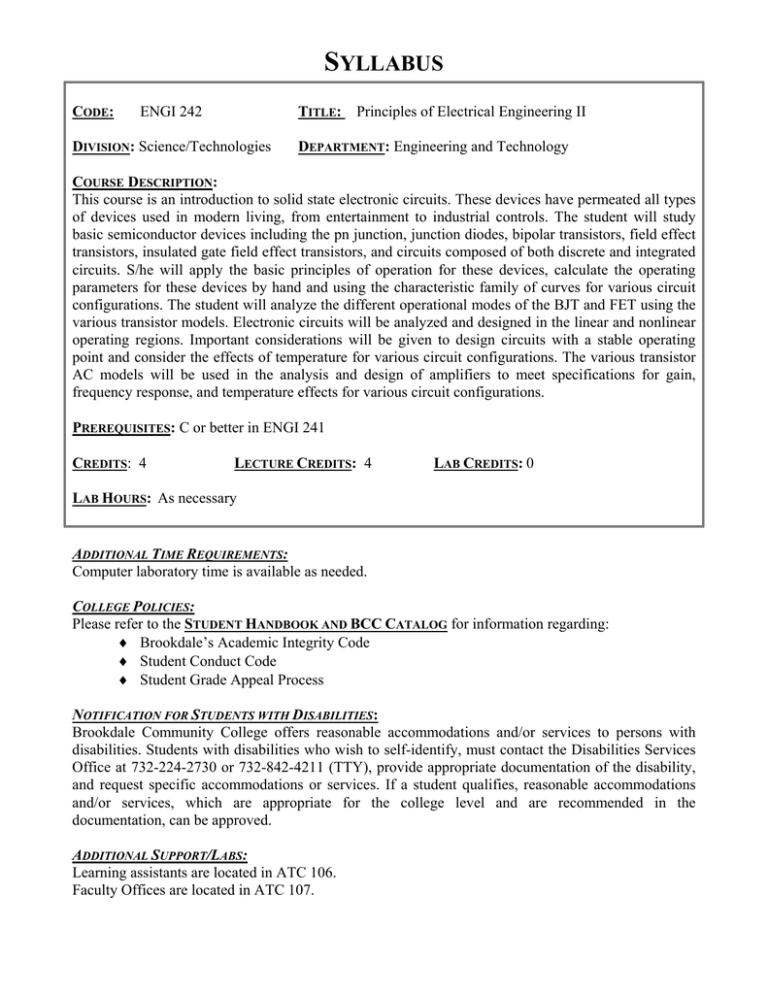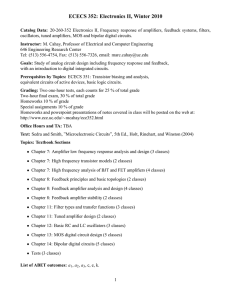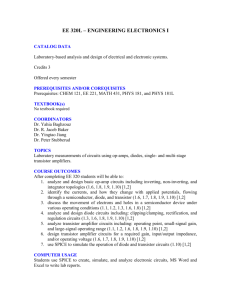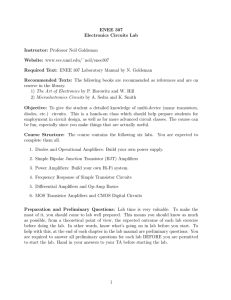ENGI 242
advertisement

SYLLABUS CODE: ENGI 242 TITLE: DIVISION: Science/Technologies Principles of Electrical Engineering II DEPARTMENT: Engineering and Technology COURSE DESCRIPTION: This course is an introduction to solid state electronic circuits. These devices have permeated all types of devices used in modern living, from entertainment to industrial controls. The student will study basic semiconductor devices including the pn junction, junction diodes, bipolar transistors, field effect transistors, insulated gate field effect transistors, and circuits composed of both discrete and integrated circuits. S/he will apply the basic principles of operation for these devices, calculate the operating parameters for these devices by hand and using the characteristic family of curves for various circuit configurations. The student will analyze the different operational modes of the BJT and FET using the various transistor models. Electronic circuits will be analyzed and designed in the linear and nonlinear operating regions. Important considerations will be given to design circuits with a stable operating point and consider the effects of temperature for various circuit configurations. The various transistor AC models will be used in the analysis and design of amplifiers to meet specifications for gain, frequency response, and temperature effects for various circuit configurations. PREREQUISITES: C or better in ENGI 241 CREDITS: 4 LECTURE CREDITS: 4 LAB CREDITS: 0 LAB HOURS: As necessary ADDITIONAL TIME REQUIREMENTS: Computer laboratory time is available as needed. COLLEGE POLICIES: Please refer to the STUDENT HANDBOOK AND BCC CATALOG for information regarding: ♦ Brookdale’s Academic Integrity Code ♦ Student Conduct Code ♦ Student Grade Appeal Process NOTIFICATION FOR STUDENTS WITH DISABILITIES: Brookdale Community College offers reasonable accommodations and/or services to persons with disabilities. Students with disabilities who wish to self-identify, must contact the Disabilities Services Office at 732-224-2730 or 732-842-4211 (TTY), provide appropriate documentation of the disability, and request specific accommodations or services. If a student qualifies, reasonable accommodations and/or services, which are appropriate for the college level and are recommended in the documentation, can be approved. ADDITIONAL SUPPORT/LABS: Learning assistants are located in ATC 106. Faculty Offices are located in ATC 107. ENGI 242 SYLLABUS REQUIRED TEXT ELECTRONICS, Second Edition, Allan R. Hambley, Prentice Hall, 2000, ISBN 0-13-691982-0 LEARNING OUTCOMES AND ASSESSMENT: Student outcomes are evaluated using graded assignments and design projects, quizzes, a midterm exam and a final exam. By their work on the exam, quizzes, and assignments, students will: ♦ demonstrate the ability to identify, formulate, and solve electronic circuit problems ♦ demonstrate the ability to design a system or process to meet desired needs ♦ demonstrate the ability to use the techniques, skills, and modern engineering tools necessary for circuit design ♦ perform basic dc and ac circuit analysis ♦ use standard lab equipment including oscilloscope, power supply, multi-meter and signal generator to make circuit measurements as well as to analyze and interpret data ♦ use engineering circuit simulation/analysis software for sinusoidal-steady state and transient analysis, and to verify circuit design ♦ demonstrate the ability to communicate effectively PARTICIPATION Active participation in this course by all students is required and expected. Attendance for all lectures is strongly advised. All computer laboratory experiments must be performed according to schedule and submitted within two weeks for grading. STUDENT PERFORMANCE EVALUATION Active participation in this course by all students is required and expected. Attendance for all lectures is strongly advised. 1. Students must submit their assignments for grading no later than two weeks after they are scheduled to be performed. Late work may be penalized at the rate of 10% per week late. 2. The progress of the student will be evaluated by class participation, graded assignments, performance, and test grades. 3. There will be quizzes, a midterm, and a final exam. There is no retest or makeup examination except for absence. 4. In order to pass the course, the student must have a passing test average, and a passing grade for the course project. FINAL GRADE The final grade will be determined by averaging each section and assigning them the following weights: 20% for the Midterm Examination 20% for the Final Examination 20% for Quizzes 20% for the Course Project 20% for Computer Simulations 100% Grade for the Course The following scale is used to determine satisfactory progress on each unit examination and for the final grade: Page 1 ENGI 242 SYLLABUS Final Grade Range A 90% to 100% B+ 85% to 89% B 80% to 84% C+ 75% to 79% C 70% to 79% D 65% to 69% F Below 65% It is the student's responsibility to submit all work on a timely basis, and it is expected that all course requirements will be completed by the last class meeting. It may be possible to obtain a grade of INC. However, this option is discouraged except in cases of severe hardship. COURSE PROJECT Each student will be required to perform a course design project consisting a PSpice simulation of a circuit. Project requirements and the circuits will be distributed by the instructor. You may obtain copy of the Student Edition of PSpice from your instructor or one of the engineering faculty. CORE COMPETENCIES This course teaches no primary cores competencies. ACADEMIC INTEGRITY Academic integrity is submitting one's own work, and properly acknowledging the work of others. Any violation of this principle constitutes academic dishonesty. Forms of academic dishonesty include: Plagiarism Submitting another's work, in whole or part, as one's own. This includes an examination, a computer program, a laboratory report, or a written assignment. Facilitating Academic Dishonesty Helping another commit an act of dishonesty, such as substituting for an examination or completing an assignment for someone else. Cheating Using or attempting to use unauthorized materials on an examination or assignment, such as using unauthorized texts or notes or improperly obtaining, or attempting to obtain, copies of an examination or answers to an examination. Illegal System Access Altering, transmitting, or permitting unauthorized individuals access to your account, or an attempt to alter or destroy system files on any server or computer. This also includes altering, transmitting, or attempting to alter or transmit academic information or records by unauthorized individuals. Any violation of this principle constitutes academic dishonesty. Students that participate in dishonest activities ♦ will receive a 0 for that project, examination, or assignment ♦ may be given a grade of F for the course ♦ may be reported to the Dean for disciplinary action For additional information, refer to the current Brookdale Community College Student Handbook. Page 2 ENGI 242 SYLLABUS COURSE SCHEDULE See http://www.brookdalecc.edu/fac/engtech/aandersen/engi242/ COURSE HOMEWORK ASSIGNMENTS See http://www.brookdalecc.edu/fac/engtech/aandersen/engi242/homework/ Page 3 ENGI 242 UNIT 1 Name Of Unit Unit Objective Method Of Evaluation Estimated Time To Achieve UNIT 1 OF 6 Diode Characteristics At the conclusion of this Unit, the student will describe the electrical properties of semiconductor crystals. The student will describe the operating characteristics of the pn junction diode and how its operation is effected by the properties of semiconductor materials. The diode V − I curves and the diode circuit models will be used in the analysis and design diode circuits. Class participation and the grading of a written examination and the homework assignments. 2 Week Learning Objectives At the conclusion of this Unit, the student will be able to describe or perform: 1. Load-Line Analysis 2. The Ideal-Diode Model. Rectifier Circuits 3. Wave-Shaping Circuits 4. Linear Small-Signal Equivalent Circuits 5. Basic Semiconductor Concepts 6. the physics of the Junction Diode 7. Switching and High-Frequency Behavior 8. Computer-Aided Analysis of Diode Circuits. Recommended Learning Experiences Class and participate in the lecture. Attend The course text Chapter 3. Read Turn In Homework 1 − Chapter 3 problems 2, 4, 5, 9, 13, 14, 15, 16 Perform PSpice Computer Lab 1 – Chapter 3 problems 92 and 93 PSpice Computer Labs Problem 92, • For the Diode, use the library component D1N4002. Use the Default Parameters. • Select Transient and enter the appropriate parameters for the General Settings. • The Run to time should be an integer value that is 5T where T = 1/60 s and make the Maximum step size small for smooth output. Problem 93 Use only a VDC source and the Diode D1N4148. For the Diode, modify the model for the following values .model D1N4148 D(Is=.1p N=1.836 Rs=20 Ikf=44.17m Xti=3 Eg=1.11 Cjo=2p + M=.3333 Vj=.5 Fc=.5 Isr=1.565n Nr=2 Bv=100 Ibv=1p Tt=10n) Perform a DC Sweep with the following options: Primary Sweep Voltage V1 0 1 1mv Secondary Sweep Temperature 0 50 100 Page 4 ENGI 242 UNIT 2 Name Of Unit Unit Objective Method Of Evaluation Estimated Time To Achieve UNIT 2 OF 6 Bipolar Junction Transistors At the conclusion of this Unit, the student will describe the basic structure and types of the bipolar junction transistors (BJT's) as a semiconductor device. The student will describe the operation of these devices based upon its input and output characteristic curves. S/he will use various transistor models to analyze the different operating parameters and configurations. Class participation and the grading of a written examination and the homework assignments. 3 Weeks Learning Objectives At the conclusion of this Unit, the student will be able to: 1. describe the structure of the bipolar junction transistor and the two types of devices − the pnp and npn. 2. draw the schematic diagram for transistor circuits with proper biasing voltages. 3. describe the operation of the transistor in terms of its V− I characteristic curves. 4. identify the regions of operation from the terminal electrical parameters. 5. apply the dc circuit models to the different configurations, and calculate the terminal voltages and currents. 6. write the various basic model equations. 7. describe the basic operation of the npn Bipolar Junction Transistor 8. perform Load-Line Analysis of a Common-Emitter Amplifier 9. design and analyze simple linear dc BJT circuits. Recommended Learning Experiences Attend Read Turn In Perform Class and participate in the lecture. The text Chapter 4.1 – 4.6 Homework 2 − Chapter 4 problems 7, 10, 19, 20, 21, 22 PSpice Computer Lab 2 – Chapter 4 problem 17 and 18 Page 5 ENGI 242 UNIT 3 Name Of Unit Unit Objective Method Of Evaluation Estimated Time To Achieve UNIT 3 OF 6 Amplifier Design and Analysis At the conclusion of this Unit, the student will analyze and design single stage amplifiers. The student will calculate and meet design criteria for voltage, current and power gain, as well as input and output impedance. Class participation and the grading of a written examination and the homework assignments. 4 Weeks Learning Objectives At the conclusion of this Unit, the student will be able to: 1. draw Bode Plots. Common-Source Amplifiers at High Frequencies 2. design BJT circuits with stable operating points. 3. use the three basic assumptions in the preliminary design. 4. describe the use of negative feedback and the effect of feedback on the circuit's operating parameters. 5. perform objectives 1 through 4 for the JFET and IFGFET in both the depletion and enhancement modes of operation. 6. identify and design the dc bias circuits for BJT amplifiers in the three configurations − the Common Emitter, the Common Collector, and the Common Base. 7. draw the hybrid π low frequency model for various transistor amplifier configurations. 8. calculate the hybrid π transistor parameters, rπ , gm, rb, and ro. 9. draw the hybrid π high frequency model for various transistor amplifier configurations. 10. calculate the hybrid π transistor parameters, cπ and cµ. 11. identify and design the dc bias circuits for FET amplifiers in the three configurations − the Common Source, the Common Drain, and the Common Gate. 12. perform analysis for the Low-Frequency Response of RC-Coupled Amplifiers. 13. calculate CinMiller, and CoMILLER. 14. calculate the upper and lower −3dB points. 15. calculate the amplifier input and output impedance . RECOMMENDED LEARNING EXPERIENCES ATTEND READ TURN IN Perform Class and participate in the lecture. Chapter 8. Homework 6 − chapter 8 problems 22, 24, 28, 30, 39, 40, 42, 43, 61, 64, 65 PSpice Computer Lab – Chapter 6 problem Page 6 ENGI 242 UNIT 4 Name Of Unit Unit Objective Method Of Evaluation Estimated Time To Achieve Learning Objectives UNIT 4 OF 6 Field Effect Transistors At the conclusion of this Unit, the student will describe the basic structure of unipolar transistors, the Junction Field Effect Transistor (JFET), and the Insulated Gate Field Effect Transistor (IGFET). The student will describe the operation of these devices based upon its input and output characteristic curves. S/he will use various transistor models to analyze the different operating parameters and configurations. Class participation and the grading of a written examination and the homework assignments. 2 Weeks At the conclusion of this Unit, the student will be able to: 1. describe the structure of the Metal−Oxide−Semiconductor Field Effect Transistor (MOSFET) junction. 2. describe the operation of the MOSFET in the depletion, inversion, and accumulation modes. 3. describe the operation of the MOSFET junction as a gate. 4. describe the structure of the JFET and IGFET, and the operating characteristics of n−type and p−type devices. 5. identify the terminal names for these devices − the gate, source, and drain. 6. properly connect voltage sources to the device. 7. draw the schematic diagram for transistor circuits with proper biasing voltages. 8. describe the operating regions (ohmic, pinch−off, threshold, drain current, and saturation current) for the JFET and IGFET. 9. describe the structure and operating characteristics of the IGFET in the depletion and enhancement mode. 10. apply both linear and nonlinear dc circuit models to analyze the operation of the FET in the depletion mode and enhancement mode. 11. design and analyze linear and nonlinear FET circuits using both ideal transistors and simple FET models. Recommended Learning Experiences Attend Read Turn In Perform Class and participate in the lecture. The course text Chapter 5.1 to 5.3. Homework 3 − Chapter 5 problems 8, 15, 16, 17, 18, 21, 22, 24, 25 PSpice Computer Lab 3 – Chapter 5 problem 24, 34A Page 7 ENGI 242 UNIT 5 Name Of Unit Unit Objective Method Of Evaluation Estimated Time To Achieve UNIT 5 OF 6 Designing Circuits for a Stable Operating Point. At the conclusion of this Unit, the student will describe the various transistor dc models. The student will use the dc model of the transistor to design practical transistor circuits. Class participation and the grading of a written examination and the homework assignments. 1 Week Learning Objectives At the conclusion of this Unit, the student will be able to describe the behavior and design: 1. Small-Signal Equivalent FET Circuits 2. Common-Source Amplifier 3. Source Follower. JFETS 4. Depletion-Mode MOSFETs Recommended Learning Experiences Class and participate in the lecture. Attend The course text Chapter 4.6 -4.9 Chapter 5.4 – 5.7, and page 343 - 348 Read Turn In Homework 4 − Chapter 4 problems 41, 42, 44, 45, 48 Homework 5 − Chapter 5 problems 28, 33, 34, 38, 39, 41, 45, 26, 57, 66 PSpice Computer Lab – Chapter 4 problem Perform Page 8 ENGI 242 UNIT 7 Name Of Unit Unit Objective Method Of Evaluation Estimated Time To Achieve UNIT 6 OF 6 Operational Amplifiers At the conclusion of this Unit, the student will design IC circuit amplifiers. Class participation, and the grading of a written examination and the homework assignments. 3 Weeks Learning Objectives At the conclusion of this Unit, the student will be able to describe the operation and design opamp circuits: 1. The Ideal Operational Amplifier 2. The Summing-Point Constraint 3. The Inverting Amplifier 4. The Noninverting Amplifier 5. Design of Simple Amplifiers 6. Op-Amp Imperfections in the Linear Range of Operation 7. Large-Signal Operation 8. DC Imperfections. Computer-Aided Analysis of Op-Amp Circuits 9. A Collection of Amplifier Circuits. Integrators and Differentiators Recommended Learning Experiences Attend Read Turn In Class and participate in the lecture. The course text Chapter 2. Homework 7 −chapter 2 problems 10, 12, 13, 22, 24, 25, 28, 34, 35, 37, 44, 45 Page 9





